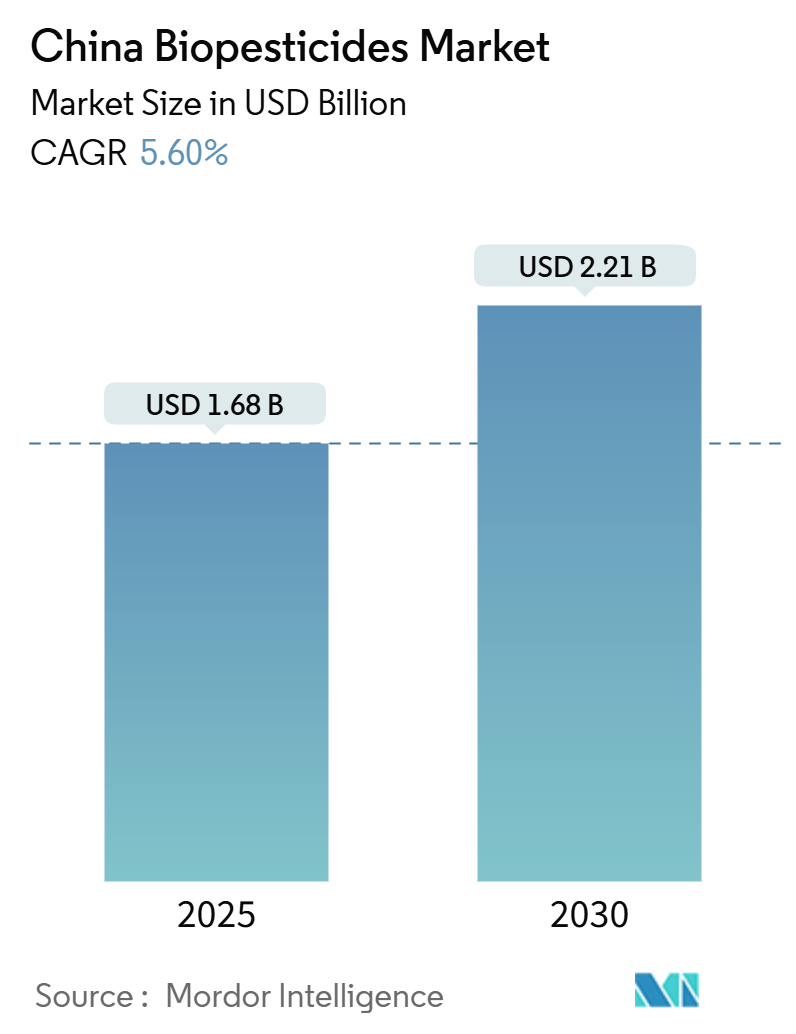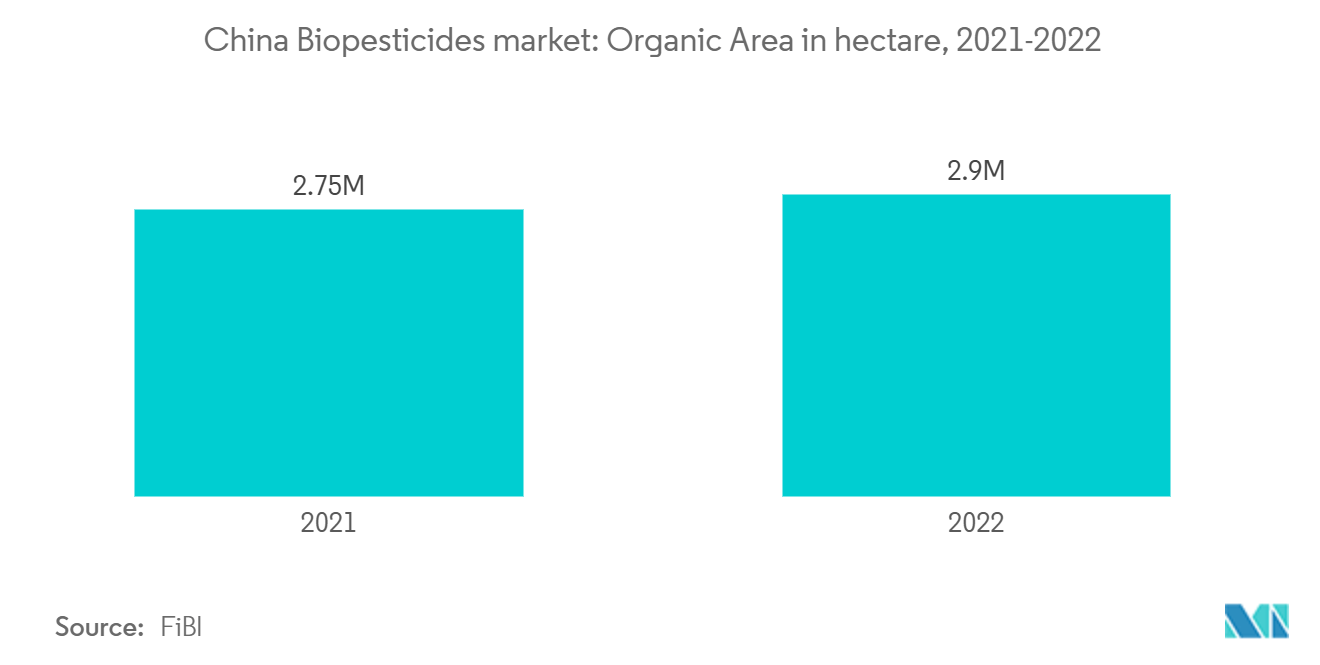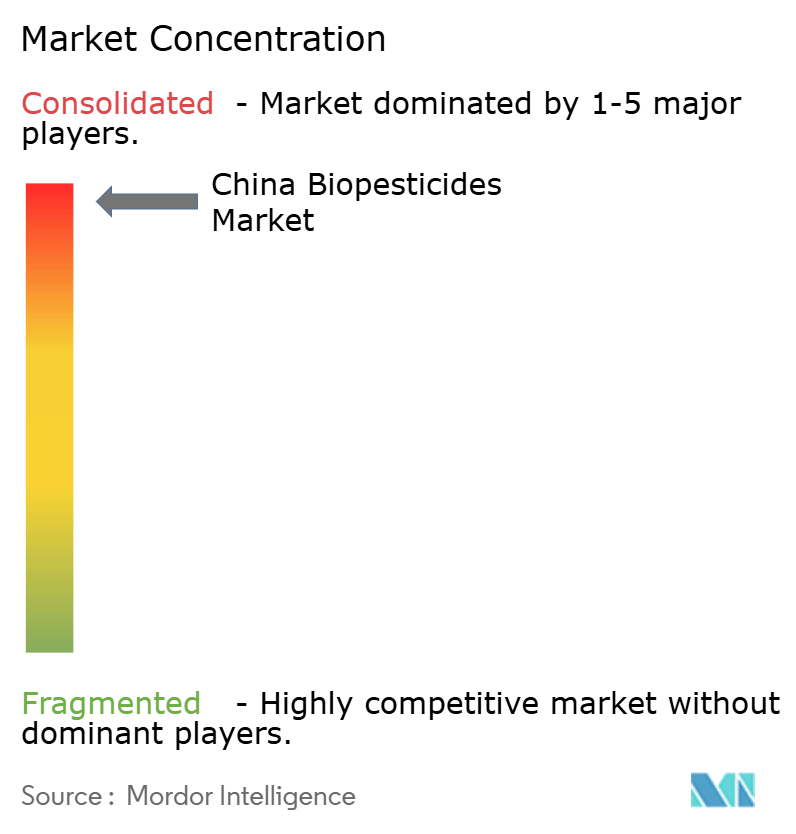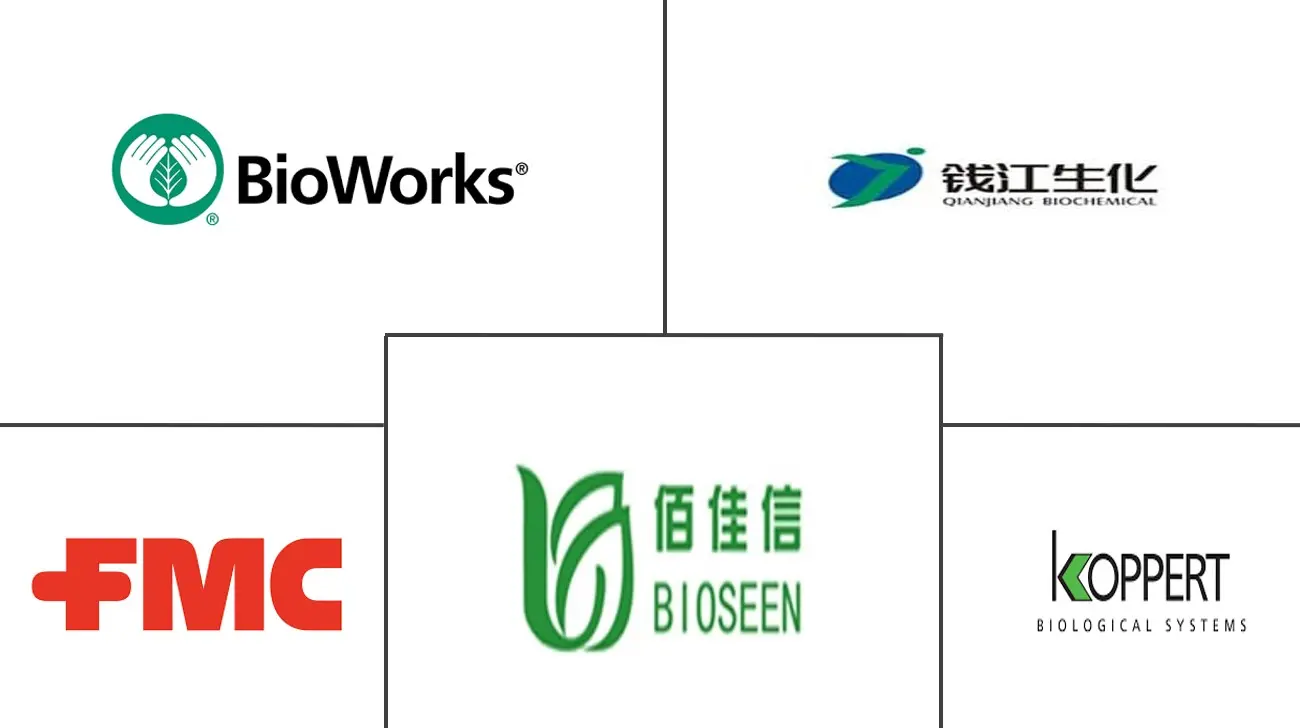
China Biopesticides Market Analysis by Mordor Intelligence
The China Biopesticides Market size is estimated at USD 1.68 billion in 2025, and is expected to reach USD 2.21 billion by 2030, at a CAGR of 5.60% during the forecast period (2025-2030).
The biopesticide market in China is experiencing rapid growth, driven by increasing demand for sustainable agricultural practices, government support for eco-friendly pest control, and rising concerns about food safety and environmental sustainability. In China, biopesticides are increasingly seen as an alternative to traditional chemical pesticides.
In a bid to champion sustainable agriculture, the Chinese government is ramping up its endorsement of biopesticides. Initiatives such as the China Green Food Development Plan, alongside a suite of environmental regulations, are steering the nation away from synthetic pesticides, nudging them toward biological alternatives. Data from 2021 reveals that out of 727 pesticide substances registered with ICAMA (Institute for the Control of Agrochemicals), 38 were biochemical, 54 microbial, and 30 botanicals. These biopesticides constituted 5%, 7%, and 4% of the total registrations, respectively.
The growing market for organic food in China, driven by health-conscious consumers, has boosted the demand for biopesticides. Organic farming standards often require the use of biopesticides, further driving growth in this sector. For instance, according to FiBL, an organic area in China was 2,753,700.00 ha in 2021, which increased by 2,898,190.80 ha in 2022.
In Chinese agriculture, Integrated Pest Management (IPM) systems are gaining traction. These systems blend biological controls, such as biopesticides, with cultural, physical, and chemical methods to reduce pest damage. Investments in biopesticide research and development are surging from both government and private sectors. In 2022, the Chinese central government prioritized green agriculture, rolling out measures like the "Action Plan to Achieve Zero Growth in Pesticide Use" and targeting over 50% GCT coverage for major crops. Both domestic firms and global entities are honing in on crafting efficient, cost-effective biopesticides suited to China's unique agricultural landscape.
China Biopesticides Market Trends and Insights
Increasing Trend of Organic Farming
Organic farming standards, both domestic (like China's organic certification) and international (such as EU or USDA certifications), impose strict limitations on synthetic chemical pesticides. Consequently, organic farmers are turning to alternative pest control methods. Biopesticides, sourced from natural entities like plants, bacteria, or fungi, emerge as a fitting solution. For instance, data from FiBL, China's organic farming area expanded from 2,753,700 ha in 2021 to 2,898,190.80 ha in 2022.
Urban centers in China, where health and environmental consciousness is heightened, are witnessing a surge in demand for organic produce. This uptick aligns with a global trend, pushing Chinese organic farmers to adopt biopesticides. Such measures ensure their produce aligns with international market standards, especially in export hubs like the EU and the U.S., known for their stringent pesticide residue limits. By utilizing biopesticides, Chinese farmers not only adhere to these food safety benchmarks but also expand their market reach.
In 2024, the State Administration for Market Regulation (SAMR) reported that China's organic product industry, with sales hitting USD 14 billion in 2023, stands as the world's third-largest market for organic product consumption. In tandem, the Chinese government is championing the organic sector, aligning with sustainable development goals and the surging demand for premium food products. To streamline this growth, the Ministry of Ecology and Environment (MEE) has rolled out regulations for national organic food production bases. This move is designed to bolster the supply of green and organic products, propelling the industry's high-quality expansion.

China's Agricultural Exports Boost Demand for Bioinsecticides
China’s agricultural exports have been increasingly linked to the growing demand for bioinsecticides. As the world’s largest producer and exporter of agricultural products, China faces a constant push to improve the sustainability and quality of its crops. Traditional chemical pesticides have raised environmental concerns and led to increased regulations. In response, bioinsecticides, which are derived from natural materials such as plants, bacteria, or fungi, have gained traction as safer alternatives.
China stands as a global leader in exporting agricultural products, spanning fruits, vegetables, cereals, and cotton. For instance, data from FAOSTAT, China's cereal exports jumped from approximately USD 1,089.9 million in 2020 to about USD 1,164.2 million in 2022. To bolster its export market share, China is aligning with global food safety standards, notably emphasizing biopesticides for residue-free products. Furthermore, as importing nations grow increasingly cognizant of pesticides' environmental repercussions, there's a heightened demand for products with minimal synthetic chemicals. This shift is steering Chinese farmers towards bioinsecticides, ensuring they remain competitive on the global stage.
Markets like the European Union, the United States, and Japan impose rigorous regulations on pesticide residues in food. With stringent limits on synthetic pesticide residues, Chinese agricultural exports face rejection if they don't comply. To navigate these challenges, Chinese farmers are turning to bio insecticide, which, due to their lower toxicity and quicker degradation, mitigate the risk of harmful residues.
In China, insect pests such as the Rice Brown Planthopper, Cotton Bollworm, and Tea Red Spider Mite are wreaking havoc on agriculture. These pests target everything from staple crops like rice and corn to high-value commodities such as cotton and fruits. Their onslaught can result in diminished yields, compromised quality, and, in severe instances, total crop failure. In response to the extensive damage inflicted by planthoppers, there's been a notable shift towards bioinsecticides. Eco-friendly options like the fungal bioinsecticide Beauveria bassiana, Bacillus thuringiensis (Bt), and other Bt-based products are now being spotlighted. These alternatives not only tackle planthopper infestations effectively but also curtail the reliance on harmful chemical insecticides.

Competitive Landscape
The China biopesticide market is fairly consolidated, companies are not only competing based on product quality and promotion but are also focused on strategic moves, to hold larger market shares. New product launches, partnerships, and acquisitions are the major strategies the leading companies in the China biopesticide market adopts. The major players include Beijing Bioseen Crop Sciences Co Ltd, Beijing Coway BioWorks Biotech Co. Ltd., Zhejiang Qianjiang Biochemical Co. Ltd., Koppert, and FMC Corporation.
China Biopesticides Industry Leaders
-
Beijing Bioseen Crop Sciences Co., Ltd
-
Zhejiang Qianjiang Biochemical Co.,Ltd.
-
FMC
-
Beijing Coway BioWorks Biotech Co., Ltd.
-
Koppert
- *Disclaimer: Major Players sorted in no particular order

Recent Industry Developments
- November 2024: Bayer CropScience AG, a leading player in the insecticides market, launched plans to introduce the globe's inaugural bioinsecticide tailored for crops. Notably, nations in the Asia Pacific, including China, Turkey, and India, stand out as key markets for bioinsecticides.
- May 2023: China's National Pesticide Registration Review Committee greenlit ten new biopesticide products, following a thorough technical review. These approvals, sought by four enterprises, including Sichuan Jinzhu Ecological Agricultural Technology Co., Ltd., mark a significant step in the country's agricultural landscape.
China Biopesticides Market Report Scope
Biopesticides are certain types of pesticides, derived from such natural materials as animals, plants, bacteria, and certain minerals. China biopesticides market is segmented by Product (Bioherbicides, Bio-Insecticides, Bio Fungicides, and Others), by Formulation (Liquid, Dry), by Ingredient (Microbial Pesticide, Plant Biopesticide, Biochemical Pesticide) by Application (Crop Based and Non-Crop Based). The report offers the market sizes and forecast values (USD) for all the above segments.
| Bioherbicide |
| Bioinsecticide |
| Biofungicide |
| Others |
| Liquid Formulation |
| Dry Formulation |
| Microbial Pesticide |
| Plant Pesticide |
| Biochemical Pesticide |
| Foliar Spray |
| Seed Treatment |
| Soil Treatment |
| Post-harvest |
| Crop-based |
| Non-crop-based |
| Product | Bioherbicide |
| Bioinsecticide | |
| Biofungicide | |
| Others | |
| Formulation | Liquid Formulation |
| Dry Formulation | |
| Ingredient | Microbial Pesticide |
| Plant Pesticide | |
| Biochemical Pesticide | |
| Mode of Application | Foliar Spray |
| Seed Treatment | |
| Soil Treatment | |
| Post-harvest | |
| Application | Crop-based |
| Non-crop-based |
Key Questions Answered in the Report
How big is the China Biopesticides Market?
The China Biopesticides Market size is expected to reach USD 1.68 billion in 2025 and grow at a CAGR of 5.60% to reach USD 2.21 billion by 2030.
What is the current China Biopesticides Market size?
In 2025, the China Biopesticides Market size is expected to reach USD 1.68 billion.
Who are the key players in China Biopesticides Market?
Beijing Bioseen Crop Sciences Co., Ltd, Zhejiang Qianjiang Biochemical Co.,Ltd., FMC, Beijing Coway BioWorks Biotech Co., Ltd. and Koppert are the major companies operating in the China Biopesticides Market.
What years does this China Biopesticides Market cover, and what was the market size in 2024?
In 2024, the China Biopesticides Market size was estimated at USD 1.59 billion. The report covers the China Biopesticides Market historical market size for years: 2019, 2020, 2021, 2022, 2023 and 2024. The report also forecasts the China Biopesticides Market size for years: 2025, 2026, 2027, 2028, 2029 and 2030.
Page last updated on:



